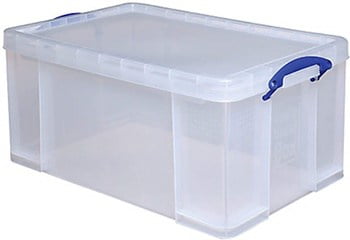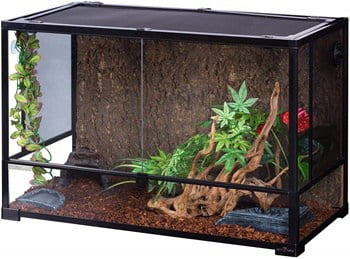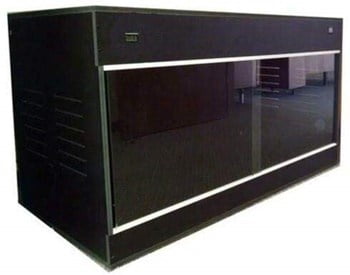Easy Diy Snake Tub Cage Cheap for Corn Snake
Corn snakes are America's second most popular pet snake, and for good reason. They're extremely docile and easy to care for in captivity. However, you still need to buy a corn snake tank and set it up correctly.
The best tank for a corn snake is a large plastic-lidded tub or a glass vivarium. Include a heat source, substrate, hides, a water bowl, and some enrichment, such as climbing branches. Your corn snake's enclosure should be long enough for your snake to stretch out fully. You'll need to upgrade the tank's size as your snake grows.
The ideal corn snake habitat has a humidity level of 40-50%, and temperatures between 72 and 90 Fahrenheit. Whichever tank you choose, it should be well-ventilated but secure enough that your snake can't escape.
What Kind of Tank Does a Corn Snake Need?
There is no standard corn snake tank size, because it depends on the length of the snake. A corn snake's vivarium should be at least long enough for it to stretch its body out completely. However, if the tank is too big, your snake could feel exposed and vulnerable to attack.
Your corn snake tank's length, plus its width, should be at least as long as your snake. So if your snake is 3 feet long, the tank could be 2 feet long by 1 foot wide.
However, this is a minimum requirement. Ideally, the length of the tank should be equal to the length of your snake. As corn snakes like to climb, it should also be tall enough to offer vertical enrichment, like branches.
If your corn snake's vivarium is too big and empty, this could cause stress. So, avoid putting a baby corn snake into a huge tank straight away. Start off small, and upgrade your snake to larger habitats as it grows.
There are 2 main options for your corn's enclosure: plastic or glass. Wooden vivariums aren't ideal, as they can grow mold and are difficult to clean.
Plastic Tubs for Corn Snakes
Plastic tubs are the cheapest type of corn snake tank. They come in various sizes, so they are suitable for juveniles and adults. The box will need a secure lid, so that your snake can't get out. You will need to drill some ventilation holes in the sides, to allow excess moisture to escape.
Plastic tubs hold in humidity well, and they're easy to clean. They're also lightweight, and easy to move around when necessary. The major drawback to plastic tubs is that it's difficult to use heat lamps with them. Heat lamps could easily melt the plastic lid, so heat mats work better.
Plastic tubs aren't particularly attractive. So if you're planning have your corn snake on display, you may prefer glass instead.
Glass Vivariums for Corn Snakes
Glass tanks are the more expensive corn snake housing option. They can cost several hundred dollars, but they are much more attractive to look at than plastic tubs.
A glass vivarium is the best option if you want to have your corn snake on display. They're transparent, so you can clearly see your snake and tank decorations through the glass.
Glass tanks don't hold on to humidity as well as plastic tubs. However, as corn snakes don't require much humidity, this won't matter unless your home is very dry.
As glass is so heavy, glass corn snake tanks are harder to move and clean. They're also extremely fragile, so pets and children should stay clear.
Most glass tanks come with a metal screen lid, which is great for use with a heat lamp. This means you can give your corn snake a basking spot.
What Are The Best Tanks for Corn Snakes?
Not all plastic tubs and glass tanks are alike. Some are designed better than others, and made of sturdier materials. Here are our recommendations.
1) Really Useful Box
Really Useful Box is a trustworthy brand of plastic storage bins. Their boxes are a favorite among snake enthusiasts because they're sturdy and have a secure locking lid. They're also lightweight and easy to clean.

Really Useful Boxes are affordable, and available in many sizes. This means that you can start your snake off with a smaller one, and upgrade it when necessary.
The Really Useful Box is an ideal size for corn snakes up to 3 feet long. The box measures 2.3 feet by 1.4 feet, and is 12 inches tall. There's plenty of space inside for all your corn snake's accessories.
The only downside to the Really Useful Box is that it's not great for display purposes. The sides are semi-transparent, so it's hard to see inside without taking the lid off.
2) Repti Zoo Reptile Glass Terrarium
The Repti Zoo Reptile Glass Terrarium is a great option if you want a glass tank for your corn snake. It's transparent and attractive, so it's great for display purposes. It has front-opening doors, so you have easy access for handling, feeding, and cleaning.

The tank comes with a secure metal screen top, so it can be used with heat lamps. The bottom of the tank is waterproof, and there are holes for ventilation, wires, and tubing.
The left and right sides of the tank are partially covered. However, you may need to cover them up further, so your snake won't feel too exposed. You can also use a decorative backdrop with this tank.
The Repti Zoo terrarium is more expensive than a plastic tub, but it's much more stylish. It measures 36" x 18" x 24", so is suitable for corn snakes measuring up to 4 feet long.
3) Critter Condo Reptile Cage
The Critter Condo Reptile Cage is the ultimate in corn snake luxury housing. It comes with a built-in thermometer, hygrometer and light fixture, so you don't need to purchase them separately. The only thing you'll need is a heat bulb and internal accessories.

The Critter Condo cage is a great choice for large adult corn snakes. It measures 48" x 24" x 24", so is appropriate for corn snakes that are up to 6 feet long. This is the largest corn snakes can get, so your snake will have a home for life.
With opaque black sides, back and roof, your corn snake will feel totally secure inside this cage. Its modern appearance will suit any home's décor. The lockable front-opening glass doors allow easy and secure access to your snake.
You'll have to assemble this cage yourself, but detailed photo instructions are provided. The only downside to this cage is that it's not suitable for use with a ceramic heat emitter.
How to Set Up a Corn Snake Tank
Once you've chosen your corn snake's new tank, you'll need to set it up. If you've opted for a glass vivarium, you may need to build it first. A plastic tub will be ready to use as soon as you've removed the packaging and washed it.
So, what does a corn snake need in its enclosure? Snakes are simple creatures, and they don't need a lot of accessories to be happy.
All a corn snake needs is a source of heat and light, access to shelter, bedding, food, and water. Enrichment items, such as branches and logs, will also help your corn snake feel at home.
Heat Lamp and Thermostat
You'll need some sort of heat source to warm your corn snake's tank. There are three main options:
- Heat lamp
- Ceramic heat emitter – a bulb which heats up but does not emit light
- Heat mat – a flat pad that heats up, and sits underneath the tank.
Create a heat gradient by placing the heat source at one end of the vivarium. Use a thermostat and thermometer to ensure temperatures stay between 72 and 90 degrees Fahrenheit.
Corn snakes like to bask, so they prefer heat lamps. However, if you're using a plastic tub, a heat mat might be the better option. As long as the tank isn't too hot or cold, your snake will be healthy.
Hygrometer
A hygrometer is a tool that measures the humidity (moisture) inside your corn snake's enclosure. This is vital, because both low and high humidity can cause health problems.
Corn snakes thrive in humidity levels of 40-50%. According to the National Renewable Energy Laboratory, 50-60% is the recommended humidity level inside the home. So, you shouldn't have much trouble providing adequate humidity for your corn snake.
A large water dish inside your corn snake's tank should be sufficient to provide moisture. You can increase the tank's ventilation if you need to remove any excess humidity.
Substrate
The best corn snake substrate is aspen. Aspen shavings are cheap, lightweight, safe and comfortable for corn snakes. Aspen is absorbent, but doesn't make the vivarium too humid. It will also retain its shape if your corn snake burrows in it.
If you can't find aspen or don't want to use it, you could opt for:
- Hemp bedding
- Reptile soil
- Paper towels or newspaper (not ideal, as corn snakes prefer to burrow)
Give your corn snake 1-2 inches of loose substrate, or a few layers of paper. Steer clear of sand, gravel and bark substrates, as they can cause impaction if inadvertently ingested.
Hides
Corn snakes can feel threatened and stressed if they're too exposed. When they're not drinking or hunting for food, they spend a lot of time in their hide box.
Ideally, your corn snake's tank should include 2 hides, one at each end. That way, your corn can choose to alternate between the cool and warm ends.
Each hide should have one entrance, and be just big enough for your snake to curl up inside. If it's too large, your snake won't feel secure. Plastic hides are easiest to clean, but you can also use wooden or ceramic hides.
Water Bowl
Your corn snake will need access to fresh, clean water at all times to stay healthy. Not only do corn snakes need water to drink, but they also enjoy bathing in it. The water bowl also helps to maintain humidity in the vivarium, as the water evaporates.
Choose a heavy, ceramic water dish that your snake can't tip over. It should be big enough for your corn snake to curl up inside, should it wish to. Clean the water dish each day, and refill it with filtered water.
Basking Rock
In the wild, corn snakes spend their mornings basking in the sun. Being ectothermic (cold-blooded), corn snakes rely on the sun's heat to move around.
Set up a large, flat rock underneath your corn snake's heat lamp at the warm end. It should be large enough for your snake to fully climb onto. Don't set it too close to the lamp, otherwise, your snake could overheat.
Enrichment Items
An enrichment item could be anything that enhances an animal's quality of life. For corn snakes, the best enrichment items are those that imitate their natural environment. For example:
- Climbing branches. According to the Journal of Experimental Zoology, corn snakes are naturally arboreal (tree-climbers). Captive corn snakes appreciate having things to climb, too.
- Plants (real or fake). Corn snakes enjoy slithering in and under leaves.
- Hollow logs. Logs provide an interesting texture to explore, and something to hide inside.
The more objects your corn snake has to climb over and hide under, the happier it will be.
Do Corn Snakes Need UV Light?
Corn snakes don't strictly need UV light to survive. Their bodies can absorb the calcium in their diet without sunlight. They've evolved to be most active at dawn and dusk, when light levels are low.
However, UVB lighting may be beneficial for corn snakes anyway. According to the American Journal of Veterinary Research, UVB radiation significantly increases corn snakes' vitamin D levels. This helps to boost their immune system. There are many other reasons why corn snakes benefit from light during the day.
- It helps emulate the snake's wild environment, and allows it to regulate its circadian rhythm
- UV radiation is antibacterial, keeping your snake's skin healthy
- Corn snakes can see more clearly in a brightly-lit vivarium, which helps reduce stress and encourage activity
Heat lamps that emit light should be switched off at night, to avoid confusing your snake. Provide an alternative source of heat during dark hours (e.g. a heat mat or ceramic heat emitter).
For further information, here's our complete corn snake care guide.
brooksbeggersewen.blogspot.com
Source: https://www.snakesforpets.com/corn-snake-tank-setup/
0 Response to "Easy Diy Snake Tub Cage Cheap for Corn Snake"
Post a Comment